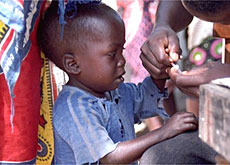Bed net project slashes malaria rates

Billboards, t-shirts and logos on buses publicised the campaign. At community meetings, local drama groups played up the benefits.
The message was simple: Going to sleep at night is the most dangerous thing your child can do. Getting under a treated mosquito net could save its life.
The results over a three-year period were spectacular – the sale of 65,000 mosquito nets and child deaths cut by 27 per cent.
The Swiss-Tanzanian project in two rural districts of southern Tanzania also offered vital clues as to how net coverage could be extended nationwide.
Market research
The Kilombero Net Project (Kinet) began in 1996 with a six-month investigation of local attitudes to malaria, mosquitoes and child death.
Market research also helped to identify customer preferences with regard to nets (green and square in two sizes) and insecticide (packaged in small sachets) as well as a suitable brand and logo for the products to be promoted.
Nets were sold for the equivalent of SFr7 and the insecticide sachets for SFr0.90.
Distribution was done through shopkeepers, community leaders and health workers in each village.
“The access of radio, television and newspapers is limited in the areas where we were working so we promoted the message through drama and during sports tournaments,” says Haji Mponda, head of social marketing at the Ifakara health research and development centre.
More than 65,000 nets and 24,000 treatments were sold by the project between May 1997 and June 2000.
Social marketing
Well before the programme got underway, several studies across Africa had shown that one of the best ways for people to avoid malaria is to sleep under an insecticide treated net (ITN).
Kinet added social marketing to the equation.
Social marketing uses the methods of commercial marketing and applies them to a product with a social benefit. It had already been successfully employed to promote the use of condoms, contraceptives and oral rehydration solutions.
The technique is well known in Switzerland since the Stop Aids campaign.
When social marketing was used in malaria control in the Kilombero Valley, it showed that ownership of nets could rise dramatically with a corresponding reduction in child deaths and illness.
“We knew about the effectiveness of ITNs but large scale implementation experience was lacking,” says Mohammadou Kabir Cham of the World Health Organization’s Roll Back Malaria campaign in Geneva.
“The Kinet study showed that using social marketing, one can increase the coverage of the use of ITNs six-fold”
Net gain
“The reduction of 27 per cent in all-cause child mortality was the really key finding,” adds Alasdair Unwin, technical cooperation officer with the national malaria control programme.
“If you extrapolate from the Kinet study, then we could be looking at saving 30,000 infant deaths a year.”
“It also demonstrated that in pregnant women using nets, there was a significant reduction in anaemia and a significant reduction in the number of low-birthweight infants born and that obviously has implications for child survival. If you have low-birthweight children, more of those die.”
The project proved it was possible to target the high-risk groups – children under five years old and pregnant women -as well as the most vulnerable members of society.
“When we looked at the ownership of nets among different socio-economic groups at the beginning, we found that only about 10 per cent of the poorest had nets,” says Hassan Mshinda, director of the Ifakara centre.
“After social marketing, we could increase the ownership of nets to almost 50 per cent of the poorest. Nets can reduce malaria; nets can reduce mortality. Through social marketing you can also reduce inequalities.”
Drawbacks
If Kinet pointed the way forward, it also suggested some of the problems that lay ahead.
Most people appear to see nets as a way of preventing mosquito bites rather than controlling malaria.
During the dry season, many people do not use a net at all even though malaria transmission is continuing.
Harder still is persuading people to retreat their nets with insecticide.
“In the two districts where we worked intensely, 80 per cent of households have at least one net but retreatment rates are below 10 per cent,” says Mponda.
Two other experiences proved important. Firstly, small shops were found to be the best place for selling the products.
Secondly, discount vouchers were available for pregnant women and those with young children, which could be used as part payment (about 15 per cent) for a treated net.
Although relatively few mothers took up the offer, the voucher proposal would later be a key component of the national programme.
swissinfo, Vincent Landon
Kinet was a social marketing programme to promote insecticide-treated nets.
The malaria control project in Tanzania ran from July 1996 to June 2000.
Some 420,000 people in the Kilombero and Ulanga districts were involved.
Kinet cut child mortality by 27 per cent and increased net usage by 60 per cent.
It led to 60 per cent reductions in anaemia and parasite levels in the blood.
The Swiss Development Agency funded the study.
It was carried out by the Swiss Tropical Institute and Ifakara Centre.

In compliance with the JTI standards
More: SWI swissinfo.ch certified by the Journalism Trust Initiative









You can find an overview of ongoing debates with our journalists here . Please join us!
If you want to start a conversation about a topic raised in this article or want to report factual errors, email us at english@swissinfo.ch.